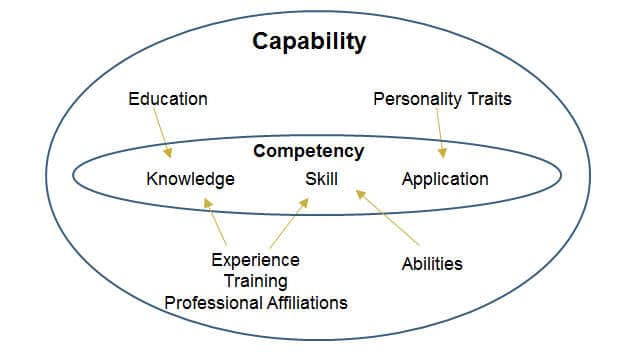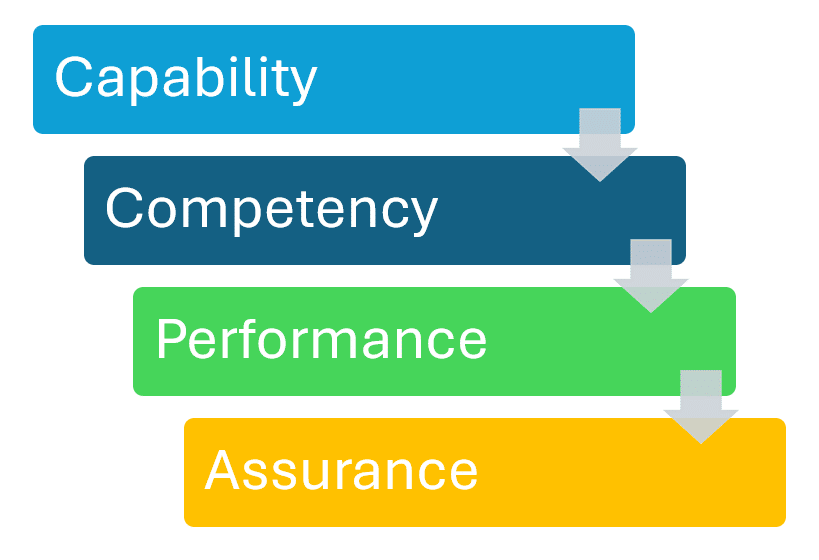Understanding how capability and competency relate is central to managing workforce performance.
Capability provides the foundation — the knowledge, training, experience, and attributes that make performance possible.
Competency represents the applied core — how those capabilities are demonstrated through knowledge, skill, and application in real work.

Capability vs Competency: What’s the Difference?
Understanding the link between potential and performance
Organizations often use capability and competency interchangeably.
In practice, they describe two related but distinct perspectives on workforce effectiveness.
Capability refers to what a person or role should be able to do, based on their qualifications, training, and experience.
Competency refers to what that person actually does — the observable behaviors, knowledge, and skill applied in context.
Recognising the distinction prevents one of the most common workforce-management errors: assuming that because people appear capable, they are competent.
Understanding the difference helps you design frameworks that link strategic requirements with real-world performance.
Defining Capability
Capability describes the capacity or potential to perform a role.
It focuses on the inputs — the knowledge, formal training, and prior experience a person brings to the job.
Typical evidence of capability includes:
- Accredited qualifications, licences, or certifications
- Documented training records or continuing-education hours
- Verified years or depth of experience
- Familiarity with particular systems, equipment, or procedures
Capability is inferred potential, not proven performance.
Someone may hold all required certifications yet be unable to apply them correctly under pressure or within a new environment.
That is why capability alone, while essential for workforce planning and compliance, cannot guarantee competence or high performance on the job.


Defining Competency
Competency represents the demonstrated application of capability.
It combines knowledge, skill, and behavior to achieve effective outcomes in specific work situations.
Competency is observed, assessed, and confirmed through performance evidence such as:
- Behavioral indicators or performance standards
- 360° or manager assessments
- Work samples or task simulations
- Peer, client, or audit feedback
Competency shows how well an individual uses their capabilities to deliver required results, reliably and safely.
Key Differences at a Glance
While both capability and competency describe “ability,” they differ in context.
Capability is typically verified in an educational or professional setting — it confirms that someone has acquired the knowledge or training to perform.
Competency is verified on the job — it proves that the person can apply that knowledge and skill to achieve consistent, safe, and effective results.
This difference is why capability alone can only infer readiness, while competency provides actual evidence of performance.
Dimension
Focus
Knowledge
Skills
Application context
Standards
Evidence Type
Level
Guarantee of performance
Use in System
Capability
Potential — what a person could do
Theoretical/Professional via education/certification
Taught/practiced in academic or training contexts
Education or professional learning environment
Benchmarked by academic/professional bodies
Qualifications Licenses, Experience, Training Records
Role/Organizational
No – capability only infers competence
Job Analysis, Workforce Planning, Compliance
Competency
Performance — what a person actually does
Practical, job relevant & demonstrated at work
Applied appropriately on the job
Real workplace operating conditions
Benchmarks organizational, operational, regulatory
Observable Behaviours, Output, Performance
Individual
Yes – proven on the job
Assessment, feedback, development
Capability infers competence; only demonstrated performance confirms it.
Why the Distinction Matters
Conflating capability with competency leads to costly blind spots:
- Staff may meet formal role requirements yet still under-perform.
- Development spending targets the wrong gaps — training people who are already qualified but not applying skills effectively.
- Compliance records show “qualified” workforces even when actual practice varies across teams.
Distinguishing between the two ensures that:
- Job design defines clear capability requirements.
- Assessments measure how well people demonstrate those capabilities.
- Learning plans focus on real competency gaps, not assumed needs.
- Risk and assurance reporting reflects true readiness, not paper compliance.

How Capability and Competency Work Together
The two frameworks form a continuous loop linking strategy, role design, and development.
- Define capability requirements to deliver on role responsibilities — the knowledge, experience, and qualifications needed.
- Map competencies that describe how those capabilities are demonstrated in practice.
- Assess competencies regularly to confirm capability is being applied effectively.
- Develop and track learning to close gaps and maintain workforce readiness.
When managed together, capability and competency create a single source of truth for workforce performance and risk management.
📈 Together they create a single source of truth for workforce readiness.
Common Misconceptions
-
“We already track training — that covers capability and competence.”
→ Training completion proves only potential; application must still be observed.“Capability frameworks are too strategic for daily operations.”
→ They underpin every practical decision about roles, performance, and development.“Competency is just soft skills.”
→ Technical and behavioral competencies together show how capability is translated into results.
Linking Capability and Competency Frameworks in Practice
A Capability Framework defines what is required of each role.
A Competency Framework defines how individuals demonstrate those requirements.
Together they connect job architecture with performance management, enabling clear alignment between organizational goals and workforce behavior.
Explore related guides:
- What Is a Capability Framework
- Understanding Organizational Capability
- What Is Competency Management
In Summary
- Capability defines potential and readiness but only infers competence.
- Competency confirms that capability is being applied effectively.
- Managing both gives an evidence-based view of workforce assurance and development priorities.
See how Centranum unites capability frameworks and competency assessment to give leaders real-time insight into workforce readiness.
FAQs – Capability vs Competency
What is the difference between capability and competency?
Capability describes the potential to perform — based on qualifications, training, and experience.
Competency describes the demonstrated ability to apply that knowledge and skill effectively on the job.
Capability infers readiness; competency confirms performance through evidence and observation.
Can someone be capable but not competent?
Yes. A person may hold all required licences and training but still perform inconsistently in real situations.
Capability provides the foundation for competence, but without assessment of application in context, it cannot guarantee effective or safe performance.
Why do organizations need both capability and competency frameworks?
Because capability frameworks define what is required of roles, while competency frameworks measure how individuals demonstrate those requirements.
Together they align job design, training, and performance assurance — creating a single, evidence-based view of workforce readiness.
